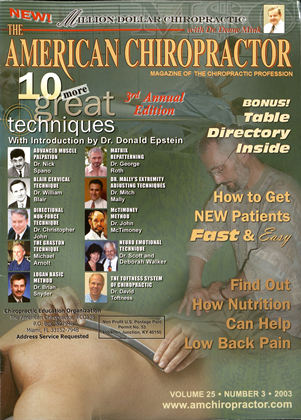Adjustment N () matter what chiropractic college you went to, your main approach to patient care is likely to be the chiropractic adjustment. This statement is not surprising to most, and it gives a clue as to how we think as chiropractors. We, basically, utilize a mechanical or biomechanical approach to care for our patients. Whether you believe the adjustment is replacing misaligned bones or restoring motion to previously hypomobile joints, your treatment approach involves mechanically thrusting into spinal tissues, i.e., a mechanical approach to patient care. Although we DCs think and treat our patients structurally, we must realize that it is the chemical mediators of inflammation that activate nociceptors, resulting in pain, which drives patients to our offices. For many years, it has been known that an acidic pH works synergistically with the chemical mediators of inflammation to activate and sensitize tissue nociceptors.1 Evidence existed regarding low back pain and pH at least as early as the 1 %0's. At the time of surgery, Nachemson discovered that the pH of lumbar discs ranged from 5.7-7.5. The lower the pH, the greater the pain, disc degeneration, and fibrous tissue deposition.2 llambly and Mooney state that it has been noted that "sick" discs, as reflected by pain on discography, have consistently demonstrated an acidic pH.1 In more recent years, researchers have demonstrated that the intervertebral disc can release potent inflammatory mediators, which naturally leads MD's to medicate injured low backs. We DCs should, of course, continue to adjust the spine, and also consider addressing the inflammation with a nutritional adjustment. Discs, Back Pain and Chemical Mediators Recent research demonstrated that intervertebral discs which cause low back pain and sciatica secrete high levels of pro-inflammatory mediators.4 At the time of surgery, disc specimens were collected from sixty-three patients undergoing primary discectomy for sciatica, and from twenty patients undergoing interbody fusion for discogenic low back pain. The average age of these patients was forty-one, so they were all young individuals who, theoretically, should be healthy and functional. A biochemical analysis of the disc specimens revealed that discs from the sciatica and low back pain groups produced significant quantities of interleukin-6 (1L-6). interleukin-8 (IL-8), and prostaglandin E2 (PGE2).4 None of the specimens produced interleukin-l (I L-l) or tumor necrosis factor (TNF). Additionally, not all discs produced IL-6, IL-8 or PGE2, which suggests that either other inflammatory mediators were responsible for the pain generation, or that altered chemistry was not responsible for the nociception and pain in these subjects. A Simple Nutritional Method to Reduce Cytokines and PGE2 A recent review article by Simopoulos explains that the omega-3 fatty acids in fish oil supplements can reduce the synthesis of IL-6, PGE2, and many other inflammatory mediators, such as IL-1,TNF, thromboxane A2 (TXA2), leukotriene B4 (LTB4), fibrino-gen and platelet-derived growth factor.5 For many years now, it has been known that fish oil has a dramatic anti-inflammatory effect that can help prevent heart disease, cancer, migraine headaches, psoriasis, ulcerative colitis, rheumatoid arthritis, and many other conditions.5 Sierkerka was the first DC to publish an article that urged DCs to use omega-3 fatty acids to accelerate the disc's healing process.6 About 1-2 grams of EPA/DHA is a common recommendation to improve omega-3 fatty acid status. Magnesium deficiency is also known to increase the release of IL-6 and PGE2, as well as 1L-1, TNF, TXA2 and LTB4.7 Animal studies suggest that substance P release from nociceptors may be responsible for stimulating such mediators to be released by local immune and tissue cells.s About 400-1000 mg of supplemental magnesium is the typical recommendation. Botanicals such as ginger and turmeric are known to inhibit the production of PGE2 and LTB4.1' These substances can be viewed as natural COX2 inhibitors, and have been used for thousands of years in India to reduced pain and inflammation. Ginger is the best buy for patients. About 2 grams per day is the typical recommendation for powdered ginger, and about 500-1000 mg, if a standardized extract is used. In addition to the above, consider using a multiple vitamin/ mineral to insure that your patients are getting all the micronu-trients necessary to drive the multitude of cell reactions required for tissue health. From a dietary perspective, make sure your patients eat lots of fruits and vegetables, and drink lots of water, perhaps one-half gallon per day. Avoiding seeds, grains and flour products is also a must, as these foods contain inflammatory omega-6 fatty acids, which is heightened by the addition of omega-6 oils, including corn, sunflower, and safflower oils. | See page 59 for References Dr. Seaman is the Clinical Chiropractic Consultant for Anabolic Laboratories, one of the first supplement manufacturers to service the chiropractic profession. He is on the postgraduate faculty of several chiropractic colleges, providing nutrition seminars that focus on the needs of the chiropractic patient. Dr. Seaman can be reached by e-mail at doc.(a}lt>.sspainbetter9olf.com.
 View Full Issue
View Full Issue






